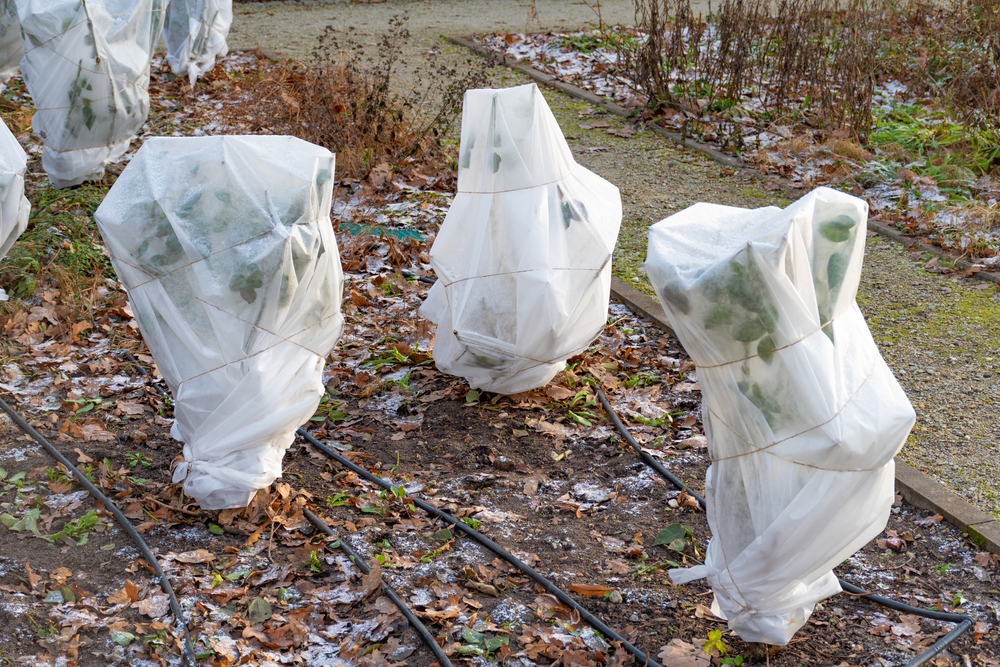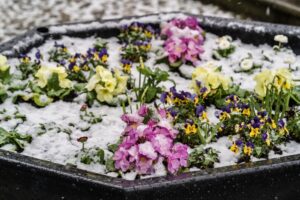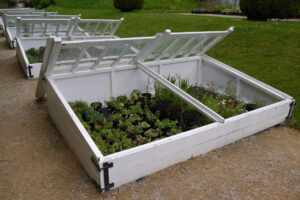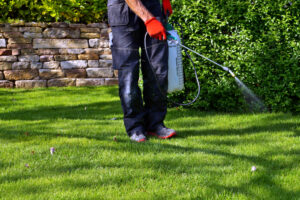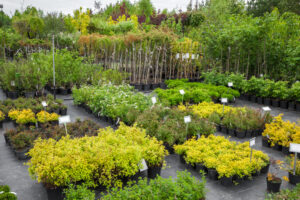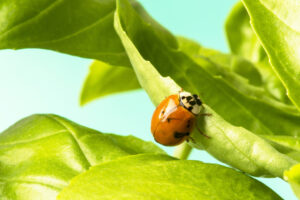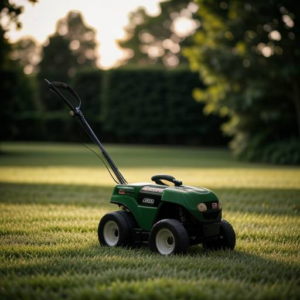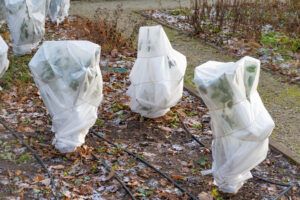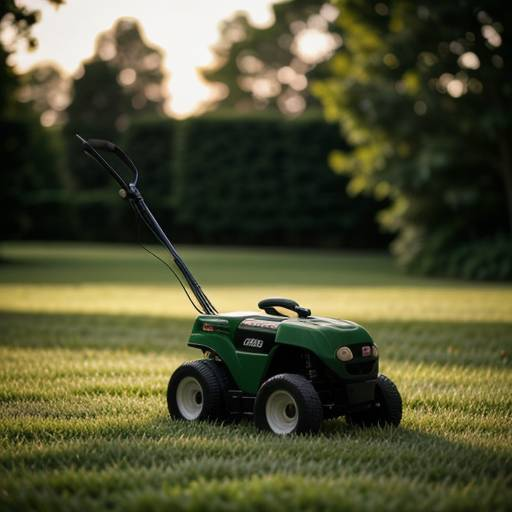As Columbia, SC, experiences its mild winter season, it’s crucial for both home and commercial property owners to prepare their gardens. This comprehensive guide will delve into the nuances of winter garden care, focusing on mulching, pruning, and frost protection.
Mulching and Soil Management
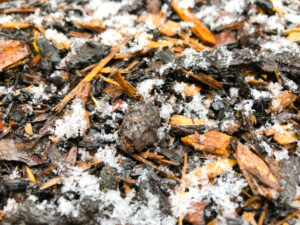
Types of Mulch for Winter Protection
In Columbia’s climate, selecting the appropriate mulch is vital for safeguarding your plants against the mild yet unpredictable winter temperatures. Consider these options:
- Straw: Excellent for insulating plants, particularly vegetable gardens. It’s light and easy to remove come spring.
- Leaves: An eco-friendly option, shredded leaves provide good insulation and enrich the soil as they decompose.
- Wood Chips: Ideal for perennial beds, wood chips offer lasting protection and improve soil structure over time.
Each type of mulch impacts soil acidity and nutrient content differently, so choose one that aligns with your garden’s specific needs.
Benefits of Mulching in Winter
Mulching in winter has several advantages:
- Insulation: It keeps the soil temperature more consistent, protecting roots from fluctuating temperatures.
- Moisture Retention: Mulch reduces water evaporation, ensuring your plants stay hydrated.
- Weed Suppression: A layer of mulch inhibits weed growth, reducing maintenance efforts.
- Soil Enrichment: As organic mulches decompose, they add vital nutrients back into the soil, promoting healthier plant growth in the spring.
Proper Mulching Techniques
Apply a 2-3 inch layer of mulch around your plants, keeping a few inches clear around stems and tree trunks to prevent rot. Over-mulching can lead to excess moisture retention and potential root diseases, so moderation is key.
Soil Health in Winter
Maintaining soil health is a cornerstone of winter gardening. Ensure good drainage to prevent waterlogging, which can be deadly for many plants during colder months. Winter is also an ideal time for soil testing; check the pH level and nutrient content to determine if any amendments are needed for the upcoming growing season.
Composting in Winter
Composting can continue throughout the winter, albeit at a slower pace. Add brown materials like fallen leaves and balance them with green kitchen scraps. Regularly turn the compost to facilitate decomposition, even in colder weather.
Pruning and Plant Care

Winter Pruning Basics
Pruning during winter (when many plants are dormant) promotes healthy spring growth. Here’s what you should focus on:
- Remove Dead or Diseased Branches: This prevents the spread of disease and encourages healthier growth.
- Thin Out Overgrown Areas: Improving air circulation within the plant can reduce disease risk.
- Shape Plants: Pruning for shape not only enhances a plant’s appearance but also promotes healthier, more controlled growth.
Protective Pruning for Frost-Sensitive Plants
Some plants may be more vulnerable to frost damage. Prune these plants to remove delicate parts that are more likely to be damaged by cold. Additionally, consider using frost cloths or moving sensitive potted plants indoors to protect them from cold snaps.
Preparing Perennial Beds for Winter
Perennial plants often require some preparation for the winter months:
- Cut Back Dead Foliage: This helps to prevent the spread of pests and diseases.
- Mulch Around the Base: A layer of mulch protects the roots from extreme temperatures.
- Divide Overgrown Plants: Late fall or early winter is a good time to divide perennials, ensuring healthier growth in the spring.
Plant Dormancy and Winter Care
Most plants in Columbia, SC, will enter a dormant state during winter. It’s important to reduce watering and stop fertilizing during this period to let the plants rest. Overwintering plants correctly ensures a vibrant and robust garden when they awaken in the spring.
Frost and Cold Protection

Frost Protection Strategies
Protecting your garden from frost is essential in Columbia, SC, especially during unexpected cold snaps:
- Timing: Keep an eye on local weather forecasts and prepare for frost protection when temperatures are expected to dip.
- Covering Plants: Use frost cloths, burlap, or even old bed sheets to cover sensitive plants. These materials allow for breathability while providing insulation. Erect temporary structures using stakes to keep the material from directly touching the foliage, as direct contact can lead to damage where the cloth and the plant meet.
- Watering Before Frost: Watering your garden the night before a frost can create a thermal blanket. As the water releases heat slowly overnight, it can slightly raise the air temperature near the plants, offering some protection against frost.
Using Burlap for Plant Protection
Burlap, with its natural fibers, is ideal for winter plant protection:
- Wrapping Techniques: For trees and shrubs, wrap burlap around the trunk and extend it to the lower branches. Secure it with twine but ensure it’s not too tight to allow for some air circulation.
- Burlap Screens: In areas of your garden that are particularly exposed to cold winds, erecting burlap screens can provide a shield, reducing the wind chill factor that can exacerbate plant stress.
Insulating Garden Beds
- Insulating Materials: Apart from mulch, consider using straw bales, leaf piles, or even old blankets to add an extra layer of insulation over your garden beds. This is especially useful for perennial beds or vegetable gardens.
- Temporary Plastic Covers: For extreme cold spells, laying a plastic sheet over the garden bed can provide additional warmth. However, remember to remove or ventilate it during the day to prevent overheating and moisture buildup.
Snow and Ice Management in the Garden
Snow and ice, while rare in Columbia, can occur and need to be managed carefully:
- Snow as Insulation: A light layer of snow can actually insulate plants. However, heavy snowfall can break branches and flatten plants.
- Ice on Plants: If ice forms on plants, resist the temptation to break it off. This can cause more damage. Instead, allow it to melt naturally.
Winter Gardening Infrastructure

Cold Frames for Winter Gardening
- Location and Orientation: Place cold frames in a south-facing location to maximize sun exposure. Ensure they are shielded from harsh northern winds.
- Cold Frame Construction: You can construct a cold frame using old windows or plastic sheeting. Make sure there is a provision for ventilation to release excess heat.
Utilizing Greenhouses in Winter
- Insulation: Adding an extra layer of bubble wrap or thermal greenhouse film can greatly improve heat retention.
- Humidity Control: Maintain adequate humidity levels to prevent plant stress and disease. This might involve using a humidifier or simply watering the soil.
Garden Tool Maintenance
- Rust Prevention: Clean your tools to remove soil and plant residue. Dry them thoroughly and apply a light oil to prevent rust.
- Tool Sharpening: Sharp tools make for easier and more efficient pruning come spring. Consider taking your tools to a professional if you’re unsure how to sharpen them properly.
Watering and Weed Control

Winter Watering Practices
- Check Soil Moisture: Before watering, check the soil moisture. Overwatering in winter can lead to root rot and other issues.
- Watering Techniques: Use a watering can or hose with a gentle spray to avoid disturbing cold, potentially fragile plants.
Winter Weed Control
- Pre-Emergent Herbicides: For larger gardens, consider using a pre-emergent herbicide in late fall to prevent winter weeds.
- Hand Weeding: Regular hand weeding can keep your garden tidy and reduce competition for resources when spring arrives.
Plant Selection and Management

Choosing Winter-Resistant Plant Varieties
Selecting the right plants for Columbia’s winters (USDA Hardiness Zone 8) is critical for a thriving garden:
- Research and Consultation: Visit local nurseries or consult with local gardening experts to find plants that are known to thrive in your specific climate and soil conditions.
- Native Plants: These plants are naturally adapted to the local climate and soil, requiring less maintenance. Examples include Carolina Jessamine and Southern Magnolia.
- Evergreens: Evergreens like holly, boxwood, and cypress provide year-round interest and can act as windbreaks or privacy screens.
Protecting Container Plants
Container plants are more susceptible to cold:
- Insulating Containers: Wrap pots in bubble wrap, burlap, or even old blankets to protect roots from cold.
- Strategic Placement: Move containers to a sheltered location, preferably against a south-facing wall to maximize sunlight exposure.
- Winter Care for Container Plants: Water them sparingly since their growth slows down in winter, but ensure they do not completely dry out.
Frost Dates and Planting Schedules
Understanding local frost dates is crucial for timing planting and harvesting:
- Local Frost Dates: In Columbia, the typical first frost occurs in early November, and the last frost occurs around mid-April.
- Adjust Planting Schedules: Plan your gardening activities around these dates to prevent frost damage. For example, plant spring bulbs before the first frost and start seedlings indoors before the last frost.
Seasonal Garden Maintenance
Cover Crops for Winter
Cover crops can significantly improve garden health during the winter:
- Soil Benefits: They prevent erosion, improve soil structure, and can add nutrients (especially nitrogen-fixing crops like clover).
- Types: Options for cover crops in Columbia include clover, winter rye, and hairy vetch.
- Incorporation into the Soil: In spring, these crops can be turned into the soil to act as green manure, further enriching the soil.
Garden Clean-up and Winter Preparation
A thorough clean-up can protect your garden through the winter:
- Removing Plant Debris: Clearing away dead plants and fallen leaves reduces habitats for pests and diseases.
- Tool and Equipment Care: Clean, sharpen, and oil your gardening tools; drain and store hoses and irrigation systems to prevent freezing.
- Infrastructure Check: Inspect and repair any garden structures like fences, trellises, or greenhouses.
Monitoring and Adjusting Winter Garden Care
Regular garden monitoring throughout winter is essential:
- Weekly Inspections: Check for signs of pest activity, frost damage, or waterlogged soil.
- Adaptation to Weather Changes: Be ready to adjust watering, covering, or protective measures based on fluctuating winter weather conditions.
Indoor and Microclimate Gardening

Indoor Gardening During Winter
Bringing the garden indoors:
- Selection of Indoor Plants: Choose plants that thrive indoors, like herbs (basil, mint), small vegetables (tomatoes, peppers), or ornamental plants (peace lilies, spider plants).
- Light and Temperature: Ensure adequate light, either natural or through grow lights, and maintain a consistent indoor temperature.
Microclimates and Winter Gardening
Leveraging microclimates effectively:
- Identifying Garden Microclimates: Observe areas that receive more sun, are protected from wind, or have better drainage.
- Using Microclimates: Plant frost-sensitive plants in these protected areas or use them to extend your growing season.
Winter Garden Design Considerations
Designing for year-round interest:
- Structural Elements: Incorporate hardscaping elements like rocks, sculptures, or water features that provide visual interest even in winter.
- Color and Texture: Add plants with colorful bark (like red twig dogwood), berries (like winterberry), or foliage (like variegated euonymus) for winter color
Pest and Wildlife Management

Winter Pest Management
Managing pests in the colder months:
- Regular Scouting: Check for signs of rodents, aphids, or other pests that can be active in winter.
- Natural Remedies and Prevention: Use natural deterrents like neem oil for aphids or protective measures like rodent guards around tree trunks.
Winter Wildlife Protection
Supporting wildlife during winter:
- Creating Habitats: Leave some areas of your garden ‘wild’ with brush piles or log stacks to provide shelter for beneficial wildlife.
- Feeding Birds: Set up bird feeders with seeds and suet to help local birds, which in turn can help with pest control.
Climate-Specific Gardening Tips
Tailoring your gardening practices to Columbia’s unique climate:
- Drought Awareness: Even in winter, be mindful of water conservation. Water plants deeply but infrequently during dry spells.
- Adapting to Weather Extremes: Be prepared for unseasonal warmth or cold snaps and adjust your garden care accordingly.

